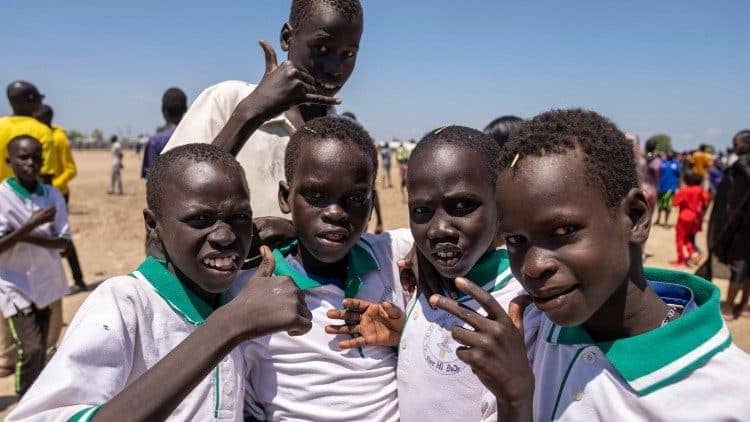YAOUNDÉ, Cameroon – As COVID-19 cases in Africa tops 1 million, Catholic Relief Services is warning the world not to ignore the drought in East Africa.
Ethiopia is suffering from the worst droughts in 50 years, laying waste to harvests and threatening over 10 million people with hunger.
“More than 30 percent of Ethiopia’s land is degraded or overstressed, driven by factors such as rapid population growth, increased human use of land, unsustainable agricultural practices. These include deforestation, overgrazing, erosion, inappropriate mining, urbanization and overcultivation,” said Zemede Zewdie, Head of Programming for CRS Ethiopia.
CRS is the official overseas development agency of the U.S. bishops’ conference.
Zewdie told Crux that CRS working together with its local partners has been able to restore over 105,000 acres of land since 2019 resulting in “tens of thousands of people benefiting from improved soil and better access to water.”
He said “the volume of water reaching downstream catchments has increased and groundwater levels have also risen.”
He also praised Ethiopian Prime Minister Abiy Ahmed’s Green Legacy Campaign, which has led to the planting of 4 billion trees in the country last year. On June 5, the prime minister set a goal of 5 billion seedlings in 2020.
“In addition to increasing vegetation coverage and helping reduce land degradation, the initiative has changed attitudes and helped people to understand the importance of tree planting,” Zewdie said.
What follows are excerpts of Crux’s conversation with Zwedie:
Crux: What is the scale of land degradation and the destruction of water sources in Ethiopia?
Zewdie: In Ethiopia, land degradation and the destruction of watersheds are two of the most serious environmental threats facing the country today. In the past, overgrazing and the increased need for farmland for cultivation and for grazing led farmers to expand to mountainous and hilly areas which normally should not be used for cultivation. People commonly use trees for firewood and construction materials. The continuous cutting of trees and removal of crop residues has exposed watersheds to erosion and land degradation. In addition, there has been no proper management of soil and water in watershed areas, so soil and water have been lost through erosion and run-off. As a result, this has created further degradation of farmland and loss of soil downstream.
What factors drive these two interconnected environmental problems?
More than 30 percent of Ethiopia’s land is degraded or overstressed, driven by factors such as rapid population growth, increased human use of land, unsustainable agricultural practices. These include deforestation, overgrazing, erosion, inappropriate mining, urbanization and overcultivation. Specifically, the clearing of forests, highlands and shrub lands for sedentary agriculture has altered the natural environment, impacted water systems, degraded watersheds, resulted in the loss of vegetation cover and led to severe soil erosion. In the wake of this, overstressed croplands have become far less productive, leaving communities that depend on these resources unable to grow food, raise livestock, or source adequate amounts of water. This can also lead to migration when the conditions are severe.
CRS has since 2017 been working with partners to change the situation. What specifically have you been doing?
Since 2019, Catholic Relief Services and its local partners have helped communities restore and return 42,760 hectares [105,662 acres] of degraded and marginal land to productivity through improved watershed and range land management including:
– Physical soil and water conservation measures (e.g. construction of soil and stone terracing/bunds and micro-basins)
– Building check dams/gabions and rehabilitating gullies to manage flooding
– Strategic multi-purpose tree planting and agroforestry
– Soil fertility improvement
– The establishment of area enclosures and enrichment plantations in degraded watershed areas to aid in the regeneration of the watershed and range lands
As a result of these initiatives tens of thousands of people are benefiting from improved soil and better access to water. In the communities where this work has been carried out, we have observed that the volume of water reaching downstream catchments has increased and groundwater levels have also risen.
Some additional stats on impacts of the initiative:
– Area of degraded land rehabilitated with area enclosure: 11,711 hectares
– Area of community watersheds treated with physical soil and water conservation measures: 7,684 hectares
– Area of community watersheds treated with biological measures: 541 hectares
– Area of Gully treated with gabion check-dam/stone/ brushwood check-dam: 42 hectares
– Number of community watersheds with a development plan: 98
– Area of cultivated land using irrigation and bench terraces after watershed rehabilitation: 390 hectares
Through a different initiative, CRS is also drilling new wells, constructing water collection points and installing integrated water systems that provide clean, reliable water to some of the most remote corners of the country.
What comment can you make about Prime Minister Abiy’s Green Legacy Campaign?
The Prime Minister’s Green Legacy initiative has also been successful in mobilizing Ethiopians to plant trees, and by extension, to curb land degradation. In 2019, more than 4 billion trees were planted, and in 2020 there is an ongoing effort to plant 5 billion seedlings. Ethiopia has already reached the halfway mark on the 2020 target. In addition to increasing vegetation coverage and helping reduce land degradation, the initiative has changed attitudes and helped people to understand the importance of tree planting.














